Knowledge base
1000 FAQs, 500 tutorials and explanatory videos. Here, there are only solutions!
This guide explains how to export customer and participant information for events (within the framework of the ticketing system Infomaniak).
Preamble
- Exports involve offering you a downloadable file in
CSVformat containing the collected information; in some cases, such as the one illustrated first below, the field separator type can be changed (e.g., semicolon). - For any information regarding the protection of personal data, refer to this other guide.
Retrieve customer information
Customers are the people who provided information by placing an order through your online ticketing system:
- Click here to access the management of your product on the Infomaniak Manager (need help?).
- Click directly on the name assigned to the ticketing related to the event.
- Click on Sales in the left sidebar.
- Click on Clients in the left sidebar.
- Click on Export customers

- Choose the criteria for the export:

Retrieve participant information
The information of the participants can be retrieved in two places:
- at the level of the form by rate: this allows you to retrieve an Excel file with all the participants' responses regardless of the date.
- For a specific event, date, or session: this will retrieve all forms used for the chosen event or date.
For a form
For this:
- Click here to access the management of your product on the Infomaniak Manager (need help?).
- Click directly on the name assigned to the ticketing related to the event.
- Click on Settings in the left sidebar.
- Click on Forms in the left sidebar.
- Select the form to export.
- Click on Export:

For a specific date
For this:
- Click here to access the management of your product on the Infomaniak Manager (need help?).
- Click directly on the name assigned to the ticketing related to the event.
- Click on Programming in the left sidebar.
- Click on Events in the left sidebar.
- Choose the event for which to export the information. In the case of a multi-date event, select the desired date.
- At the bottom of the page, click on the link Export ticketing form data to retrieve a file in
csvformat:
This guide explains how to sell tickets with a pay-what-you-want price (within the Infomaniak ticketing system).
Preamble
- This pricing allows visitors to indicate the amount they wish to pay for their ticket.
- The pay-what-you-want price is not available in the case where the event takes place in Lausanne and is subject to the entertainment tax.
- The minimum price must be more than CHF/EUR 2.- due to the banking fees associated with online transactions.
Manage the pay-what-you-want prices for your event
To do this:
- Click here to access the management of your product on the Infomaniak Manager (need help?).
- Click directly on the name assigned to the ticketing concerned by the event.
- Click on Programming in the left sidebar menu.
- Click on Events in the left sidebar menu.
- Click directly on the name of the event.
- Then click on the chevron to the right of the Modify button.
- Click on Add / modify a price:

- Choose to Add a price.
- Choose the Pay-what-you-want price.
- Specify the name and minimum prices in the desired currencies.
- Activate any advanced settings.
- Click on Next to proceed to the selection of dates and zones:

The display of the pricing varies depending on the type of event: for a multi-date event, it is managed via an action menu on the "Modify" button, while for a single-date event, it appears directly in the "Prices" tab at the top of the page.
This guide explains how to collect and retrieve customer information when they order tickets through the ticketing system.
Set up a contact form
To collect information from customers:
- Click here to access the management of your product on the Infomaniak Manager (need help?).
- Click directly on the name assigned to the ticketing system related to the event.
- Click on Settings in the left sidebar.
- Click on Customer Registration in the left sidebar.
- Enable the information to request from customers and choose the visibility:
Visible and mandatory
Visible, but optional
Invisible (do not ask)

Add additional fields
It is possible to add additional information to this form:
- Click on the Add button.
- Give a name to the field and choose the type of field.
- Depending on the field type, complete with the options from the dropdown menus or checkboxes:

This guide explains how to duplicate an event from one ticketing system to another within the framework of the ticketing system Infomaniak.
Introduction
- The duplicated event will retain all the information and parameters of the event, except for the information related to the general parameters of the ticketing system and dates.
- Please carefully check all the information that requires manual updating.
- If necessary, refer to this other guide regarding the duplication (unique or recurring) of an event on the same ticketing system.
Duplicate an event
Prerequisites
To duplicate an event from one of your ticketing systems to another, you need to go to the ticketing system from which you want to duplicate the events, season or previous edition, for example:
- Click here to access the management of your product on the Infomaniak Manager (need help?).
- Click directly on the name assigned to the ticketing system where the event to be duplicated is located.
- Click on Scheduling in the left sidebar.
- Click on Events in the left sidebar.
- Click on the action menu ⋮ located to the right of the event to duplicate.
- Click on Duplicate:

- In the modal that opens, enable the option Duplicate to another ticketing system and select which one:

- If necessary, indicate the new name of the event, the new dates, and the other parameters of your event's performances.
- Click on Confirm to start duplication.
This guide explains how to use scanners to check tickets for your event (as part of the Infomaniak ticketing system).
Set up the control tools
To activate your control tools on your ticketing:
- Click here to access the management of your product on the Infomaniak Manager (need help?).
- Click on Manage to the right of the Control Tools section:

- Select the ticketing system for your control session.
- Click the Confirm button:

- Choose one of the control methods:

- Mobile app Infomaniak Etickets scan (application for iOS/Android smartphone or tablet).
- Rent a barcode/QR code reader.
- Paper printout (not recommended for more than a few dozen customers).
Use the scanner
Hardware requirements
- Plug in the base power supply, and place the scanners on it to charge them.
- The scanners are configured to automatically connect to the Infomaniak network generated by the Wifi and 4G hotspots.
- If no connection is detected, check the connection in the device's Settings menu.
For this:
- Log in to the mobile app using one of the following methods:
- Email address and password of the Infomaniak user account with access to the ticketing system.
- Organizer code (see point 2 above).
- Code generated in the menu Profile Management (or click on the action menu ⋮ located to the right of the relevant profile to display a QR code replacing the code):

- Select the dates at the top if needed to display the correct events.
- Select one or more events to scan (long press on each for multi-selection).
- Point the camera at the ticket's QR code to perform the scan.
- The scanner will indicate whether the ticket is valid or not:
- Refer to this other guide regarding the customization of the display during the scan.
- The various scanner options are located in the menu at the top left.
Manage the app settings
On the main page
- Quick ticket cancellation
- Allows you to scan pre-printed tickets (your unsold tickets) to quickly put them back on sale without having to check the orders in the Infomaniak Manager.
- Scan Mode
- Normal - Classic scan, the ticket is allowed to enter once.
- Entry / Exit - Validates tickets in either mode to allow participants to enter and exit.
- Multiple Entries - Validates and allows entry multiple times, ticket never refused (unless it is the wrong date).
- Laser Mode
- Bluebird - to make the application compatible with Bluebird devices.
- Zebra - to make the application compatible with Zebra devices.
On the event page
- Order search
- Allows you to find an order with the visitor's name or order number.
- Flash
- Enables the flash on the device.
- Scan by zone
- Allows you to limit tickets assigned to the selected zones.
This guide explains how to set up and use the 4G terminal to connect your sales pack or scanners linked to the ticketing system Infomaniak.
Introduction
- The 4G terminal functions as an access point for your on-site sales machines and scanners.
- It connects to a mobile phone network and creates a network to which tablets, printers, and scanners will connect.
- There is no need to use the Ethernet RJ45 connection to use the 4G terminal.
Setting up the 4G terminal
Prerequisites
- Have sufficient mobile network coverage for the 4G terminal to function.
Watch the video guide:
Operating the terminal
- Press the button on the top of the machine for approximately 4 seconds. The screen will light up:
 .
. 
- The device automatically connects to the Swisscom network and is ready to use. You can check the number of devices connected to the device with a simple press of the button:

- The number of days remaining is a countdown at the end of the month and has no impact on the use of the device…
- Once the device is turned on and connected to the 4G network, it will create a network named Infomaniak.
- The Infomaniak printers, tablets and scanners will automatically connect to this network.
This guide explains how to configure your IDP Smart51 badge printer for printing from the computer of your passes (as part of the ticketing system Infomaniak).
Printer Configuration
To this end:
- Access your computer's printer manager
- Select the IDP Smart 51 printer, then the option Printers and Scanners Preferences

- In the Resin Extract option choose Black Dots Only
- Paper size: CR80 Card (54x86mm)
- Orientation: Portrait
- AJUSTER: print all image


- It is possible to save these settings in order to keep them in memory
Read more
- Start Guide : Ticket
- Printing passes from a computer
- Installation and use of badge printers for passes
- Change the printer ribbon
- Printing passes from a tablet
This guide explains how to configure the questions asked to visitors when ordering a pass / subscription (as part of the ticketing system Infomaniak).
Preamble
- This information will be linked to the passes and is therefore independent of the order form.
- These settings will be available once the pass has been created.
- For an overview of the pass and everything it can do, refer to this other guide.
Setting up pass-related information
To do this:
- Click here to access the management of your product on the Infomaniak Manager (need help?).
- Click directly on the name assigned to the ticketing system related to the event.
- Click on Scheduling in the left sidebar.
- Click on Pass in the left sidebar.
- Click on the name of the pass concerned.
- Click on the Settings tab:

- Enable the desired options:
- Title: dropdown menu offering a choice between Mr. and Mrs.
- Name: text field to enter the name
- First name: text field to enter the first name
- Organizer, Company: text field to indicate the company
- E-mail: text field to enter the email address
- Address: 5 text fields for the number and street, city and country
- Zip code : add a field between the number and street for the zip code
- Mobile phone : field for the phone number
- Date of birth: add a calendar to enter the date of birth
- Photo: allows you to upload a photo that can be displayed on the pass
- Free field: text box for free information
This guide explains how to install IDP PVC badge printers for printing tickets for your ticketing system.
Badge printers are designed to work with the mobile kiosk on the tablet as well as the web kiosk on your computer. It can be connected to the network or used directly by connecting a USB cable.
What do you want to do
Video Guide
Learn more
This guide explains how to install the driver for the badge printer (as part of the ticketing system Infomaniak) and print from a computer using the USB cable.
Prerequisites: driver installation
Driver installation is only necessary when using the web ticket office for pass printing. Using the mobile ticket office from a tablet is Plug&Play:
- Turn on and connect the printer to the computer with the USB cable.
- Go to the download site: The IDP corps website, Support and Download tab.
- Select Product: SMART-51 Series and Product model: SMART-51S…
For Mac and Linux, click on EXPAND ALL + to select the correct version of your operating system.
Printer setup
For optimal use of the printer, it is recommended to configure the printer before using it.
Printing passes from a computer
Once the printer driver has been installed:
- Connect the printer to the computer.
- Open the front of the printer and insert the badges with the printable side facing up:

- On the computer, go to the Ticket Office.
- Search for an order with a pass. You can click on Search for a reservation at the top of the ticket office for a quick search:

- In the pass section of the window that opens, click on Imprimer les pass to generate the PDF:

- From the generated PDF, start printing by selecting the Smart 51S printer.
This guide explains how to set up a validation system for passes or subscriptions (within the framework of the ticketing system).
Introduction
- This option allows you to create passes for which visitors complete a registration that you can validate before they can be used.
- This feature will be useful for any restricted access or when validation of the request must be done by the organizer.
- This can include accreditation requests, registrations for specialized courses requiring the verification of certain documents, access to certain areas or events, etc.
- This can include accreditation requests, registrations for specialized courses requiring the verification of certain documents, access to certain areas or events, etc.
Setting up the pass to validate
To do this:
- Click here to access the management of your product on the Infomaniak Manager (need help?).
- Click directly on the name assigned to the ticketing related to the event.
- Click on Scheduling in the left sidebar.
- Click on Pass in the left sidebar.
- Click on Add a pass.
- During the pass creation process, enable Pass Validity by setting it to Yes.
- This action will automatically set the necessary options for this feature, namely a free custom pass with a minimum of 0 tickets.
Once the pass is created, you will need to configure the information requested from the visitor by going to the pass and clicking on the Settings tab:
It is thus possible to make each field hidden , visible
, or mandatory
…
If more information or supporting documents are required, it is possible to add them using the form function:
- Create a form by price with the information requested from the visitor.
- Associate the price form with the pass:

Procedure for requesting a pass to be validated
The visitor will be able to order the pass like any other order procedure. A few differences should be noted:
- The terms used during the online procedure will refer to validation requests instead of orders.
- The visitor will receive a first email confirming that their request has been received and that they will be notified when their request is validated.
- The visitor will receive the pass in a confirmation email when the pass is validated.
Procedure for validating a request
To validate a pass validation request from a visitor, you will need to go to the list of passes:
- Click here to access the management of your product on the Infomaniak Manager (need help?).
- Click directly on the name assigned to the ticketing related to the event.
- Click on Sales in the left sidebar.
- Click on Pass in the left sidebar.
If needed, use the filter to display only the passes to validate and choose the desired pass category: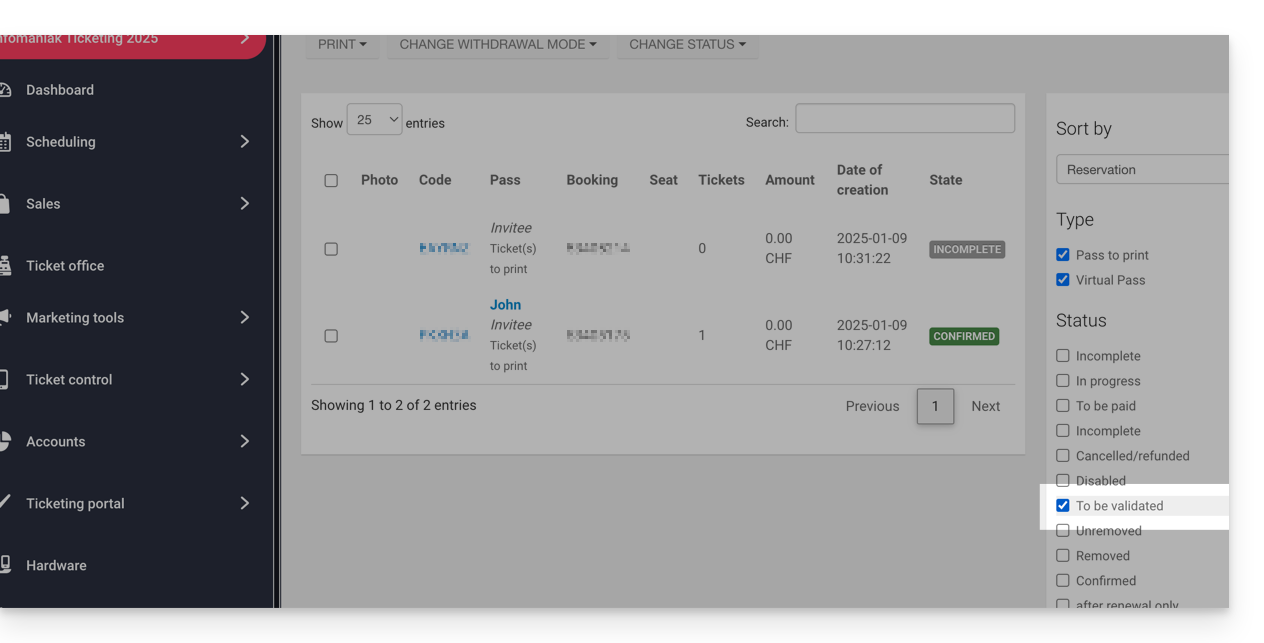
Verification before validation
Click on the passes to verify. All the information is on the pass page.
If additional fields have been added via a form, they will be found in the Edit information section:
Example with files that the user has uploaded:
Change the status
Change the status to Validated and Withdrawn or no, so that the pass is valid:
An email will be automatically sent to the visitor with the information to fill out their pass with the tickets to be added.
In case of a refusal, it is possible to send an email to the visitor to invite them to change the information.
It is also possible to do this on the previous page via a multiple selection, for example:
This guide shows an example of a pass configured as a subscription where all events are included upon purchase (within the framework of the ticketing system Infomaniak).
Preamble
- For an overview of the pass and everything it can do, refer to this other guide.
The ticket pack
The example below allows for a pass that acts as a pack of several tickets. Typical uses for this type of pass would include:
- A pass with entries for 2, 3 or 4 nights of a multi-day festival.
- A pass with different activities, such as a package "museum entry with meal" where the entry and the meal are two individual and distinct events.
- A ticket pack including entry to multiple venues on the same day.
Creating the pass
After filling in the information, such as the name of the pass, the price, or the quantity of passes available, you need to set the pass to Automatic:
The pass is configured as a ticket so that participants can print each ticket individually:
Event Association
The events are associated with the pass, with a limit of one ticket per event and no additional cost:
This pass includes a ticket for event 1 and a ticket for event 2:

Pass design
This pass will never be printed, as only the individual tickets linked to the events will be printed. Therefore, there is no need to configure the pass's visual. The customer who purchases this pass will receive a ticket for event 1 and a ticket for event 2, so you will need to define the visual of these tickets.
Information requested
This pass is not personalized, but to facilitate identification, we give the possibility to enter the first and last name:
This guide explains how to split reservations with multiple tickets (within the framework of the ticketing system Infomaniak).
This allows you to validate part of a reservation, in case the reservation includes multiple tickets, but only part of it needs to be validated at the counter.
Prerequisites
- This operation requires that an order is currently set to pay on site.
- For more information about this payment method and how to activate it, refer to this other guide.
Splitting from the web ticket office
To do this:
- Click here to access the management of your product on the Infomaniak Manager (need help?).
- Click directly on the name assigned to the ticketing for the event in question.
- Click on Guichet in the left sidebar:

- Find the reservation from the search field at the top of the page; you can find the order using the order number or any other element related to the order:

- The reservation appears in the right column; if it is a reservation, you can click on the arrow to the right of the Validate button and Split the reservation:

- The next screen allows you to select the tickets to validate:

- Now, simply proceed with the validation of the selected tickets. You will notice that this action creates a new order, and the original order will only contain the tickets not selected during the split:

Splitting from the sales tablet
The procedure for splitting an order on a tablet is similar to the procedure on the web check-in:
- Log in to your Infomaniak account.
- Click on the Orders tab and find the order to split.
- Click on the Tickets tab of the order:

- Select the tickets to validate and click on Split:

- Continue the order to validate it:

- The new order appears as validated, and the initial order shows the remaining tickets:

This guide provides the list of triggers to use for your trackers of type Google Tags and Meta pixel (Facebook) for your store (as part of the ticketing system Infomaniak).
These triggers must be inserted into the “HEAD” section of the advanced options on your store.
Examples of Meta pixel and Google Tags
Refer to the external documentation for the pixel Meta:
!function(f,b,e,v,n,t,s){
if(f.fbq)return;
n=f.fbq=function(){n.callMethod?
n.callMethod.apply(n,arguments):n.queue.push(arguments)};
if(!f._fbq)f._fbq=n;
n.push=n;n.loaded=!0;
n.version='2.0';
n.queue=[];
t=b.createElement(e);
t.async=!0;
t.src=v;
s=b.getElementsByTagName(e)[0];
s.parentNode.insertBefore(t,s)
}(window,document,'script','https://connect.facebook.net/en_US/fbevents.js');
document.addEventListener("ike_event_view", function( e ) {
fbq('init', '14085424191xxxxx');
fbq('track', "PageView");
fbq('track', 'InitiateCheckout');
});
document.addEventListener("ike_cart_payment_launched", function( e ) {
fbq('init', '14085424191xxxxx');
fbq('track', "PageView");
fbq('track', 'Purchase', {value: e.detail.topaid, currency: e.detail.currency.name});
});… and for the Google Tag Manager (GTM) + gtag.js:
window.dataLayer = window.dataLayer || [ ];
function gtag(){dataLayer.push(arguments);}
gtag('js', new Date());
gtag('config', 'UA-xxxxxxx-x');
document.addEventListener("ike_event_view", function( e ) {
gtag('event', 'view_item', {
'event_category' : e.name,
'event_label' : e.date
});
});
document.addEventListener("ike_cart_add", function( e ) {
gtag('event', 'add_to_cart');
});
document.addEventListener("ike_cart_confirm", function( ) {
gtag('event', 'checkout_progress', {
'event_category' :'valid cart'
});
});
document.addEventListener("ike_cart_payment_launched", function( e ) {
gtag('event', 'add_payment_info', {
'event_category' : 'paiement',
'event_label' : e.detail.currency.name,
'value': e.detail.topaid
});
});On Google Tag Manager, make sure the format for the tags is properly respected:
(view_item|add_cart|add_payment_info)
CSP and its impact on conversion tracking
The “Content Security Policy” (CSP) is a web security policy that protects pages against certain attacks such as Cross-Site Scripting (XSS) and the injection of malicious content. However, it can also block certain legitimate scripts, such as Meta tracking pixels or Google Tag Manager, thus preventing the proper functioning of conversion tracking.
Why don't some pixels work?
If your website displays an error related to the Content Security Policy (CSP), particularly in the console or the network tab of the browser's developer tools, this means that certain third-party scripts—such as Google tags or Meta (Facebook) pixels—are blocked. To ensure proper functioning of conversion tracking on your store, it is necessary to add a specific exception in the CSP configuration of your site to allow the resources used by the Infomaniak ticketing system.
Main CSP directives impacting tracking
script-src: defines the authorized sources for scripts.img-src: controls images (including the<img>tags used for tracking pixels).connect-src: manages tracking requests sent to the servers of marketing tools.
For example, if you use Google Tag Manager or Facebook Pixel, make sure your CSP policy explicitly allows the loading of scripts and the sending of data to their domains. Here is an example of directives to include in your CSP, to be adapted according to your configuration:
script-src 'self' https://www.googletagmanager.com https://www.google-analytics.com https://connect.facebook.net;
img-src 'self' https://www.google-analytics.com https://www.facebook.com;
connect-src 'self' https://www.google-analytics.com https://www.facebook.com;Google provides a detailed guide on configuring CSP compatible with its tracking tools.
Also, check that your security management system (application firewall, CDN, CMS) does not block these resources, and apply the necessary adjustments to ensure proper triggering of tracking events.
If your CSP is too restrictive, it can prevent the loading of third-party scripts such as:
- Facebook Pixel (connect.facebook.net)
- Google Tag Manager (GTM) (www.googletagmanager.com)
- Google Analytics (www.google-analytics.com)
Errors visible in the developer console (Browser Developer Tools):
Refused to load the script 'https://connect.facebook.net/en_US/fbevents.js'
because it violates the following Content Security Policy directive: "script-src 'self'"- Missing data in Google Analytics or Facebook Ads Manager.
- Failure to trigger events defined in GTM.
When the CSP blocks these resources, they cannot collect data on visitors or record conversion events.
Complete list of triggers
Home page:
trigger : ike_home_view
Data : none
document.addEventListener("ike_home_view", function(e) {
//send to your tracking tool
});Event page:
A page for an event with multiple dates
trigger: ike_event_view
Data: detail.name
document.addEventListener("ike_home_view", function(e) {
console.log(e.detail.name);
//send to your tracking tool
});Date page:
Page of a date of an event
trigger : ike_date_view
Datas : detail.name, detail.date
document.addEventListener("ike_home_view", function(e) {
console.log(e.detail.name, e.detail.date);
//send to your tracking tool
});Pass page:
Page of a pass category
trigger: ike_abo_view
Data: detail.name
document.addEventListener("ike_abo_view", function(e) {
console.log(e.detail.name);
//send to your tracking tool
});Pass selection page:
Page for selecting pass dates
trigger: ike_abo_selection
Data: detail (cart details)
document.addEventListener("ike_abo_selection", function(e) {
console.log(e.detail.name, e.detail.date);
//send to your tracking tool
});User login:
Triggered on successful login
trigger: ike_user_login
Data: detail (cart details)
document.addEventListener("ike_user_login", function(e) {
console.log(e.detail);
//send to your tracking tool
});User logout:
Triggered when a user logs out
Data: detail (cart details)
document.addEventListener("ike_user_logout", function(e) {
console.log(e.detail);
//send to your tracking tool
});Cart add:
Triggered when an item is added to the cart
Trigger: ike_cart_add
Data: detail (cart details)
document.addEventListener("ike_cart_add", function(e) {
console.log(e.detail);
//send to your tracking tool
});Cart page:
Trigger: ike_cart_view
Data: detail (cart details)
document.addEventListener("ike_cart_view", function(e) {
console.log(e.detail);
//send to your tracking tool
});Cart update:
Triggered when a cart element is updated
Trigger: ike_cart_update
Data: detail (cart details)
document.addEventListener("ike_cart_update", function(e) {
console.log(e.detail);
//send to your tracking tool
});Cart empty:
Triggered when the empty button is pressed
Trigger: ike_cart_empty
Data: detail (cart details)
document.addEventListener("ike_cart_empty", function(e) {
console.log(e.detail);
//send to your tracking tool
});Cart confirm:
Triggered when the confirm button is pressed
Trigger: ike_cart_confirm
Data: detail (cart details)
document.addEventListener("ike_cart_confirm", function(e) {
console.log(e.detail);
//send to your tracking tool
});Cart delivery page:
Trigger: ike_cart_delivery_view
Data: detail (cart details)
document.addEventListener("ike_cart_delivery_view", function(e) {
console.log(e.detail);
//send to your tracking tool
});Cart form page:
Trigger: ike_cart_form_view
Data: detail (cart details)
document.addEventListener("ike_cart_form_view", function(e) {
console.log(e.detail);
//send to your tracking tool
});Cart payment page:
trigger: ike_cart_payment_view
Data: detail (cart details with paymentMethodSelected)
document.addEventListener("ike_cart_payment_view", function(e) {
console.log(e.detail);
//send to your tracking tool
});Cart payment changed:
Trigger: ike_cart_payment_changed
Data: detail.path
document.addEventListener("ike_cart_payment_changed", function(e) {
console.log(e.detail);
//send to your tracking tool
});Cart payment launched:
Trigger: ike_cart_payment_launched
Data: detail (cart details)
document.addEventListener("ike_cart_payment_launched", function(e) {
console.log(e.detail);
//send to your tracking tool
});Cart payment success page:
trigger: ike_cart_payment_success
Data: detail (cart details)
document.addEventListener("ike_cart_payment_success", function(e) {
console.log(e.detail);
//send to your tracking tool
});Cart delete item:
trigger: ike_cart_delete
Data: detail (previousCart and newCart)
document.addEventListener("ike_cart_delete", function(e) {
console.log(e.detail);
//send to your tracking tool
});Page Changed:
trigger: ike_page_changed
Data: detail.path
document.addEventListener("ike_page_changed", function(e) {
console.log(e.detail);
//send to your tracking tool
});This guide explains how to manage orders and print tickets from the mobile ticket office (as part of the ticketing system Infomaniak).
Preamble
- For an overview of the mobile ticket office, refer to this other guide.
4. Printing orders
To do this:
- Select the order to print.
- If you are in the sales process and have just validated an order, it will be selected by default when you reach this step.
- Click on the desired printer to print the ticket(s):

- In the case of a pass, the mobile ticket office will indicate the available badge printers:

Print a receipt with the ticket
You can print a receipt for the order by activating the option on the right of the prints. The receipt will be printed at the end of the tickets:
Search for an order and filter the order list
It is possible to filter the list of orders or perform a specific search. The search field allows you to use all information related to the order, such as the name, email address, order number, etc.
You can also filter orders by event date.

Manage orders
Each order has options allowing you to manage it more precisely:
- Add or modify the order's client:

- Send by email the invoice, the tickets or the confirmation email, or print the receipt:

- Manage tickets individually, either to print a selection of tickets, or, for reservations, split the reservation:

- If the order contains passes, access the pass options:

- If the order contains gift certificates, display them and copy the code to the clipboard:

Next steps
- Send the cash report (Coming Soon)
- The mobile ticket office settings (Coming Soon)
This feature allows subscribers who cannot attend one or more events during the season to sell the relevant tickets (included in their subscription) directly on the ticket office (within the framework of the Infomaniak ticketing system).
Preamble

- When a subscription holder cannot attend an event, they can put tickets up for resale from their pass menu.
- The resale of pass tickets only works for passes with numbered fixed seats.
- The areas concerned by the resale of pass tickets must have public rates (and not just pass rates).
- This ticket will be put back on sale on your ticket office and can be purchased by a new person following the normal ticket sales procedure.
- The proceeds from resales can be, at the choice of the ticket holder:
- refunded, fully or partially, to the owner-seller of the pass ticket
- credited, fully or partially, to the account of the owner-seller's pass
- converted into a donation for an association designated by the organizer
The refunds of resales to the subscription holder are the responsibility of the organizer.
Creation of the pass ticket resale campaign
Prerequisites
Then:
- Click here to access the management of your product on the Infomaniak Manager (need help?).
- Click directly on the name assigned to the ticket office concerned by the event.
- Click on Programming in the left sidebar menu.
- Click on Pass in the left sidebar menu.
- Click on Subscription ticket resale:
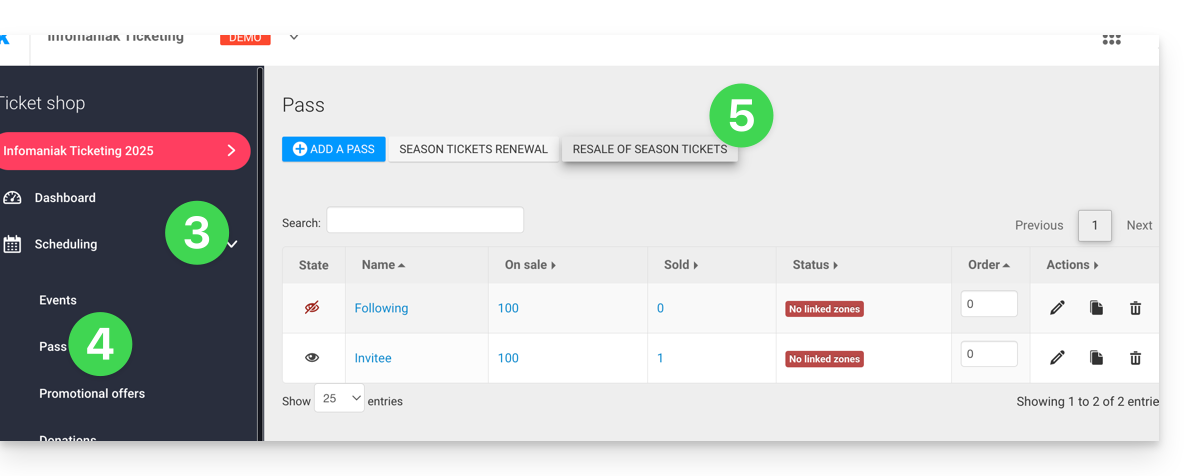
- Click on Add a resale campaign:
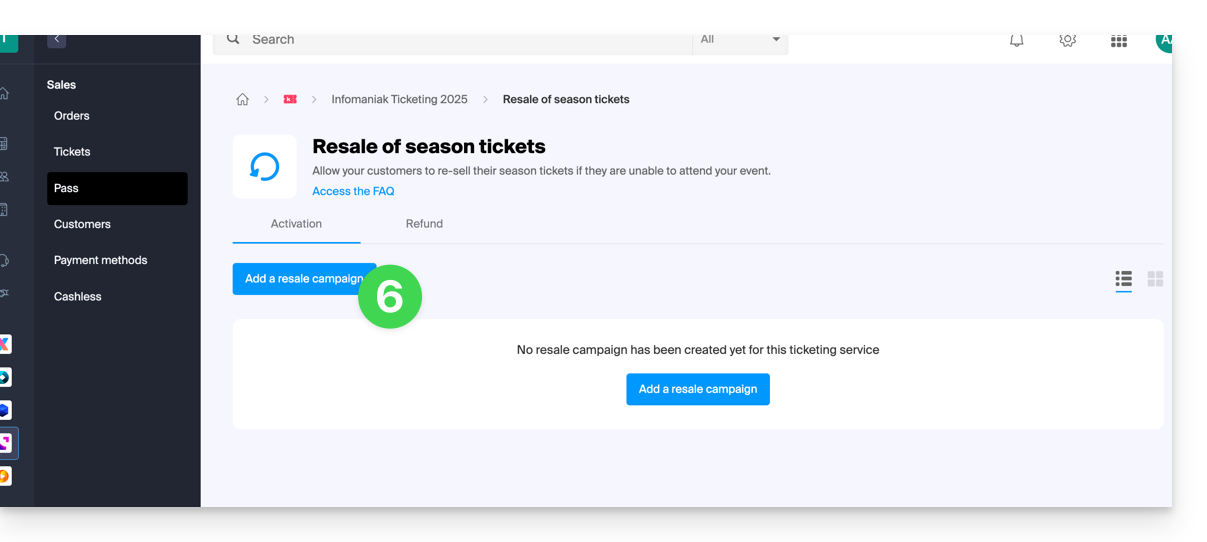
- Choose the pass for which to activate resales.
- Define the percentage of the resale price that will go to the subscription holder as well as the refund method:
- Bank transfer: the subscription holder will be invited to provide their bank details.
- Credit on the subscriber's pass to be reused for future purchases on the ticket office or for pass renewal.
- Define whether the subscriber can donate the amount to the organizer:
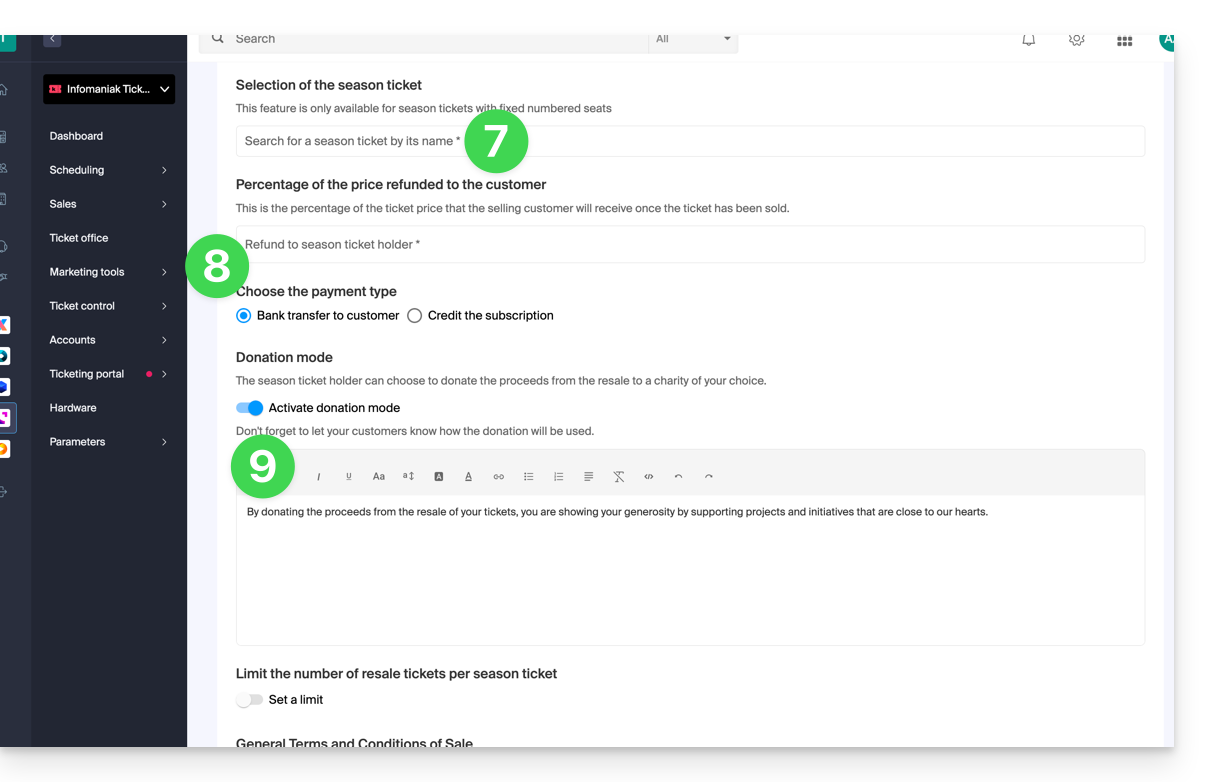
Procedure to be followed by the subscriber wishing to resell tickets
For customers wishing to resell their pass tickets, they will need to be provided with the link allowing them to access the resale page.
To do this, please generate the link to the desired ticket office, and add /pass-area at the end. Here is an example:
https://infomaniak.events/shop/abcABC4242I/pass-area
The subscriber can then follow this guide for managing their resales.
Tracking of ticket resales
The status of resales is viewable at any time from the Refund tab: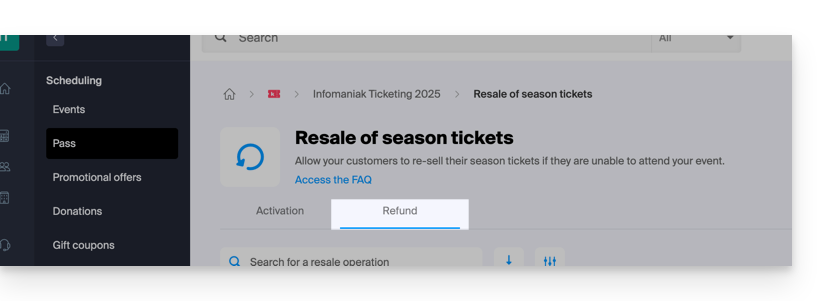
In the case of a bank refund, the bank details are available directly in the action menu ⋮ located to the right of the concerned item:

This guide explains how to configure the appearance of your pass (within the Infomaniak ticketing system).
For an overview of the pass and everything it can do, refer to this other guide.
Access the pass menu
To do this:
- Log in to your Infomaniak space
- Go to the
Ticketing
- From the left menu, under Programming, click on Pass
- Click on an existing pass
If you do not yet have a pass, refer to this other guide.
Set the visual appearance of the pass in PVC card R80 format
It is possible to set the color of the information appearing on the pass and the background image:
To change the background image, click on select a file and once the image is chosen, click on Save:
Appearance of the pass ticket
If the medium chosen for the pass is in ticket format, you can define a template for printing. You will need to create a ticket visual and save a template beforehand.
You can then simply choose the template you want:
Learn more
This guide explains how to use your bank's CAMT files to automatically validate orders paid by invoice (as part of the Infomaniak ticketing system).
Preamble
- If customers decide to pay an order by invoice, they receive an invoice directly with your banking information.
- You must therefore check if the payment has been received and manually validate the customer's order.
- The following procedure allows you to automate a large part of this procedure, and you can thus simply validate the orders in a few clicks.
Import the CAMT file
Prerequisites
- Make sure you have indicated a QR-IBAN to generate QR Invoices.
- CAMT imports require that the bank records the information related to the order, and this information is only present if the customer uses the QR-Invoice when paying the invoice.
- Please contact your bank to find out how you can retrieve a CAMT file (example of documentation).
Next:
- Click here to access the management of your product on the Infomaniak Manager (need help?).
- Click directly on the name assigned to the ticketing concerned by the event.
- Click on Sales in the left sidebar menu.
- Click on Orders in the left sidebar menu.
- Click on the top right button:

- Import the CAMT file:
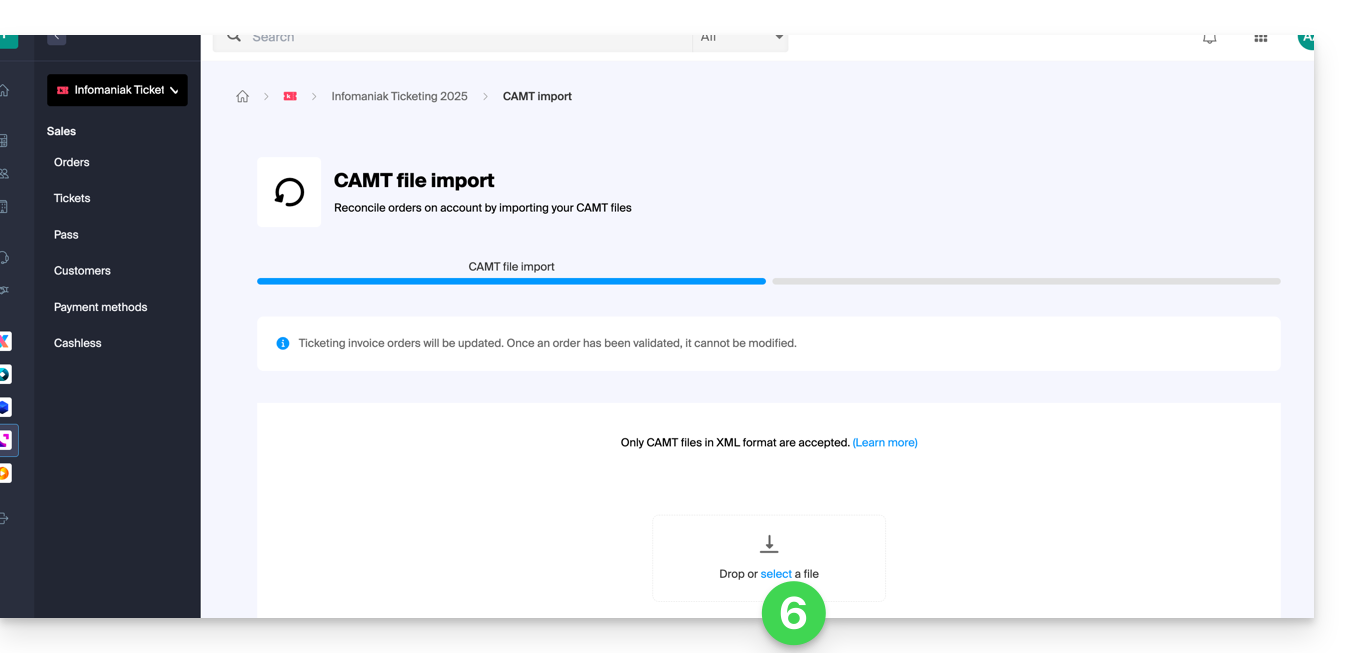
- Select the orders to validate:
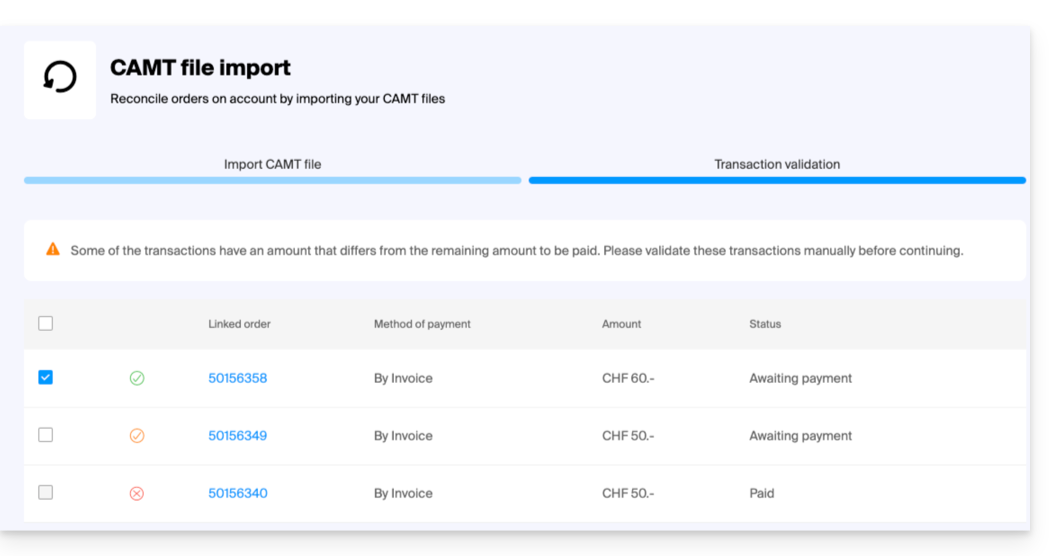
- The orders for which the payment corresponds to the amount of the invoice will be automatically selected.
- Orders with a partial payment can be manually validated, but will be recorded as complete on the ticketing.
- Once the orders to validate are selected, click on Validate the selected transactions.
- The orders are automatically set to validated:
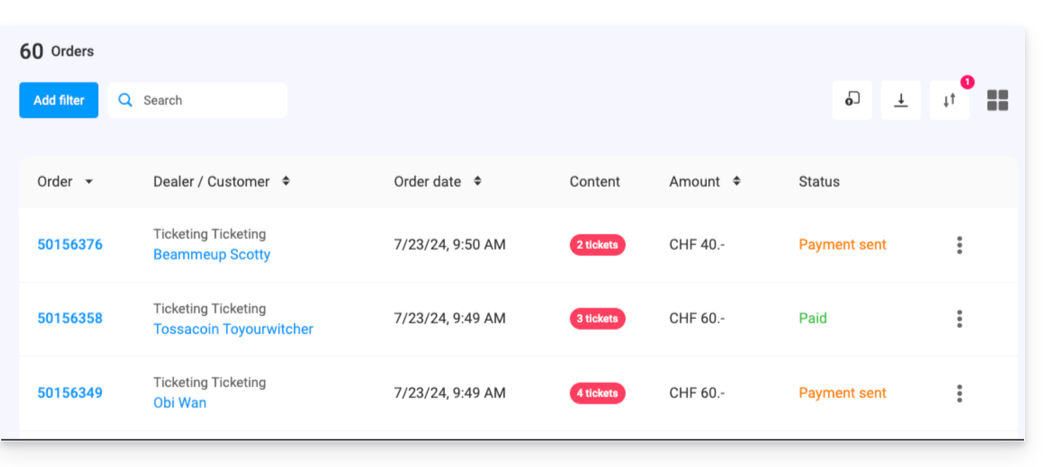
This guide explains how to modify the display of your events (within the framework of the Infomaniak ticketing system).
Access the options to configure the display
To do this:
- Click here to access the management of your product on the Infomaniak Manager (need help?).
- Click directly on the name assigned to the ticketing concerned by the event.
- Click on Programming in the left sidebar menu.
- Click on Events in the left sidebar menu.
- Click on the name of the event concerned:
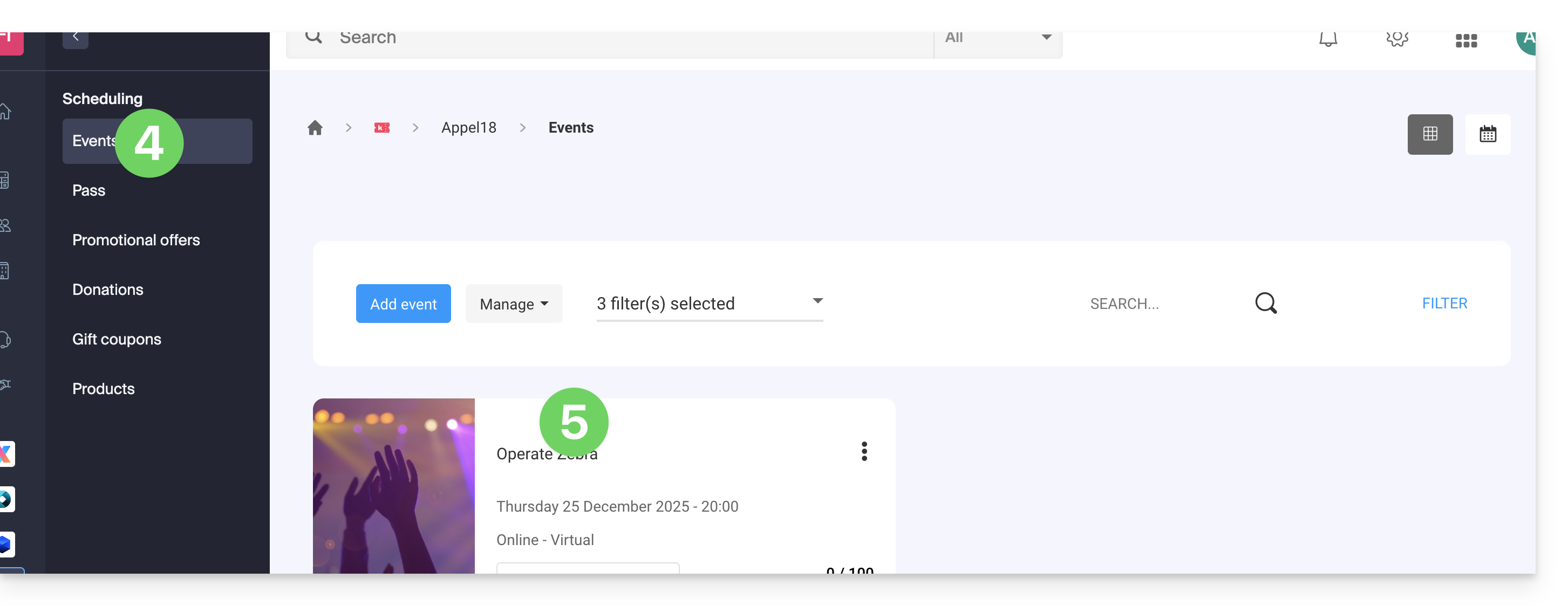
- Click on the Edit button:

Choose a multi-date event display mode
To do this:
- Add new possible dates...
- Choose the methods for displaying these dates on the calendar; these modes will be available on the online ticketing and will allow your customers to switch between the different display modes they prefer (see below)...
- Choose which display mode will be used by default...
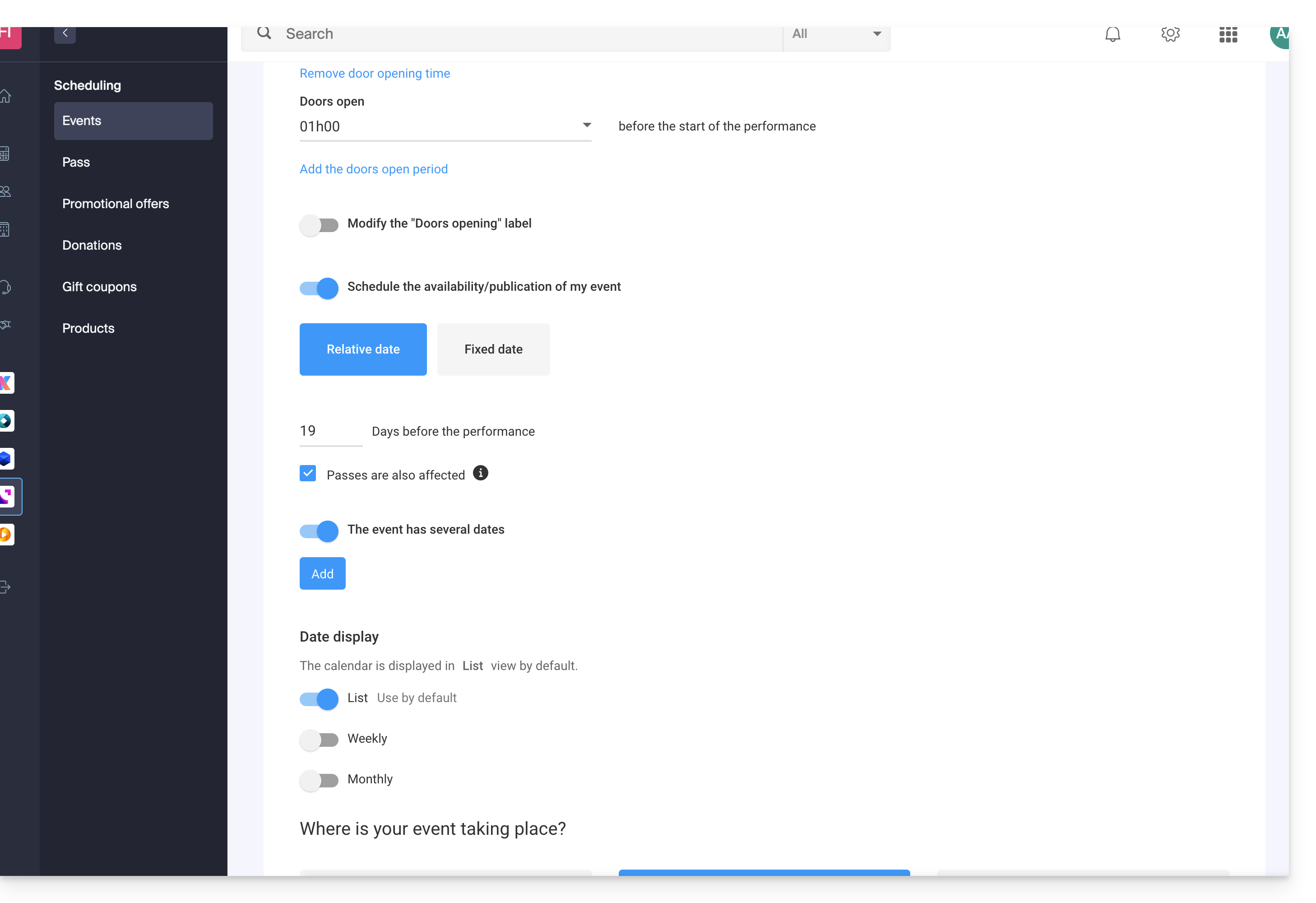
The different available displays
The list display
The list display is practical if the dates are spaced out over time with empty periods (weekly, or monthly for example) and/or if the ticketing needs to be able to offer several dates or sessions, without these being indicated on a calendar.
The monthly calendar
The monthly calendar allows you to place events on a monthly calendar. It is an effective display, but can be very busy if there are many sessions per day.
The weekly calendar
Very useful if you want to display the dates week by week, especially if there are several performances per day, or in the case where the event only lasts for a short period, and you want to display the days of the week.
This guide explains how to easily assign a customer to a pass when the latter has an address entered (within the framework of the Infomaniak ticketing system).
Prerequisites
- The customer record must exist with an associated email address.
- The pass must have an email address entered so that this feature can suggest customers to link.
- You must therefore make the option visible or mandatory in the pass configuration:

- You must therefore make the option visible or mandatory in the pass configuration:
Place the order by entering the email address
When adding passes to the cart, or once they are in the cart, please enter an email address. Multiple passes, each with their own email address, can be in the cart:
Only one customer can be linked to an order.

Once the pass is validated, on the Customer tab, an additional field will offer you the choice of customers to link to the order:


